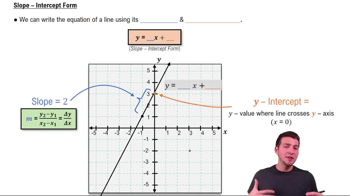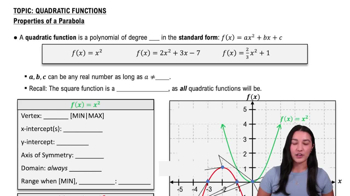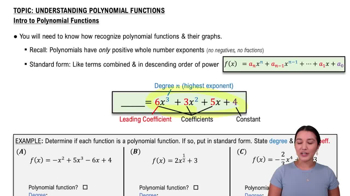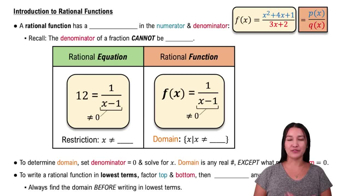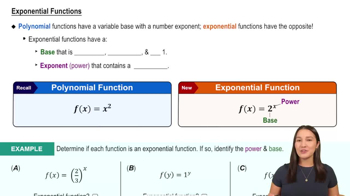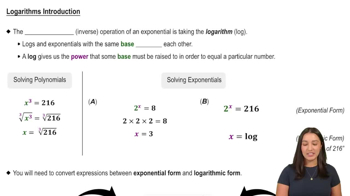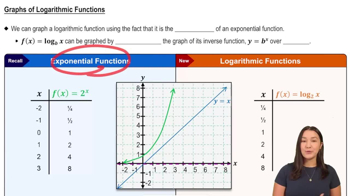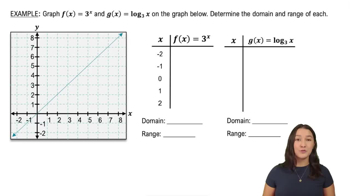Table of contents
- 0. Functions7h 52m
- Introduction to Functions16m
- Piecewise Functions10m
- Properties of Functions9m
- Common Functions1h 8m
- Transformations5m
- Combining Functions27m
- Exponent rules32m
- Exponential Functions28m
- Logarithmic Functions24m
- Properties of Logarithms34m
- Exponential & Logarithmic Equations35m
- Introduction to Trigonometric Functions38m
- Graphs of Trigonometric Functions44m
- Trigonometric Identities47m
- Inverse Trigonometric Functions48m
- 1. Limits and Continuity2h 2m
- 2. Intro to Derivatives1h 33m
- 3. Techniques of Differentiation3h 18m
- 4. Applications of Derivatives2h 38m
- 5. Graphical Applications of Derivatives6h 2m
- 6. Derivatives of Inverse, Exponential, & Logarithmic Functions2h 37m
- 7. Antiderivatives & Indefinite Integrals1h 26m
0. Functions
Common Functions
Problem 77g
Textbook Question
Explain why or why not Determine whether the following statements are true and give an explanation or counterexample.
If , then
 Verified step by step guidance
Verified step by step guidance1
Step 1: Understand the problem statement. We are given a function \( f(x) = \frac{1}{x} \) and need to determine if its inverse \( f^{-1}(x) \) is also \( \frac{1}{x} \).
Step 2: Recall the definition of an inverse function. For a function \( f(x) \), its inverse \( f^{-1}(x) \) satisfies the condition \( f(f^{-1}(x)) = x \) and \( f^{-1}(f(x)) = x \).
Step 3: Apply the inverse function condition to \( f(x) = \frac{1}{x} \). Assume \( f^{-1}(x) = \frac{1}{x} \) and check if \( f(f^{-1}(x)) = x \). Substitute \( f^{-1}(x) \) into \( f(x) \): \( f(f^{-1}(x)) = f\left(\frac{1}{x}\right) = \frac{1}{\left(\frac{1}{x}\right)} = x \). This condition holds.
Step 4: Check the second condition \( f^{-1}(f(x)) = x \). Substitute \( f(x) \) into \( f^{-1}(x) \): \( f^{-1}(f(x)) = f^{-1}\left(\frac{1}{x}\right) = \frac{1}{\left(\frac{1}{x}\right)} = x \). This condition also holds.
Step 5: Conclude that both conditions for inverse functions are satisfied, so the statement is true. The inverse of \( f(x) = \frac{1}{x} \) is indeed \( f^{-1}(x) = \frac{1}{x} \).
Recommended similar problem, with video answer:
 Verified Solution
Verified SolutionThis video solution was recommended by our tutors as helpful for the problem above
Video duration:
2mPlay a video:
Was this helpful?
Key Concepts
Here are the essential concepts you must grasp in order to answer the question correctly.
Function and Inverse Function
A function maps each input to a single output, while an inverse function reverses this mapping. For a function f(x), the inverse f^{-1}(x) satisfies the condition f(f^{-1}(x)) = x for all x in the domain of f^{-1}. Understanding this relationship is crucial for determining whether the given statement about f(x) and its inverse is true.
Recommended video:

Derivatives of Other Inverse Trigonometric Functions
Domain and Range
The domain of a function is the set of all possible input values, while the range is the set of all possible output values. For the function f(x) = 1/x, the domain excludes zero, as division by zero is undefined. When analyzing the inverse function, it is essential to consider how the domain and range of f affect those of f^{-1}.
Recommended video:
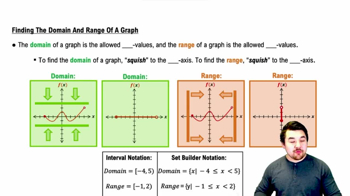
Finding the Domain and Range of a Graph
Counterexamples
A counterexample is a specific case that disproves a general statement. In the context of functions and their inverses, providing a counterexample involves finding a value for which the proposed relationship does not hold. This is a critical skill in calculus, as it helps clarify the conditions under which statements about functions and their inverses are valid.

 5:57m
5:57mWatch next
Master Graphs of Common Functions with a bite sized video explanation from Nick
Start learningRelated Videos
Related Practice



